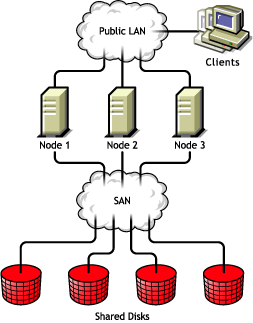1.3 Storage Area Networks
In a typical NCS configuration, clustered nodes share the data resources of a Storage Area Network (SAN) or other type of shared disk system so that if one node in the cluster fails, the services and data previously presented by that node are seamlessly handled by another node in the cluster.
Figure 1-3 Typical Connections between Network Servers and a SAN

The combination of NCS and Storage Area Networks (SANs) enables provides high availability to their network service and data resources. SANs facilitate the sharing of data resources between network servers.
With SANs, storage devices need not be tied to a single server, but can be physically connected to multiple network servers. In a SAN environment, since all network servers in an NCS cluster have a physical connection to the shared data, NCS can quickly migrate resources from a failed network server (node) to another node in the cluster. The process of moving or restarting a cluster resource to a surviving node from a failed node is referred to as Fan-out Failover.
Connections between network servers and a SAN are typically made with fiber optic cable at data speeds of up to 400 MB per second. Fiber optic connections allow for distances of up to 10 kilometers between the SAN and the network servers. Even though the distance between the SAN and the network servers may be significant, data access is no slower than if accessed locally.
To provide fault tolerance at the disk level, SAN configurations typically employ RAID Level 5 disk subsystems.